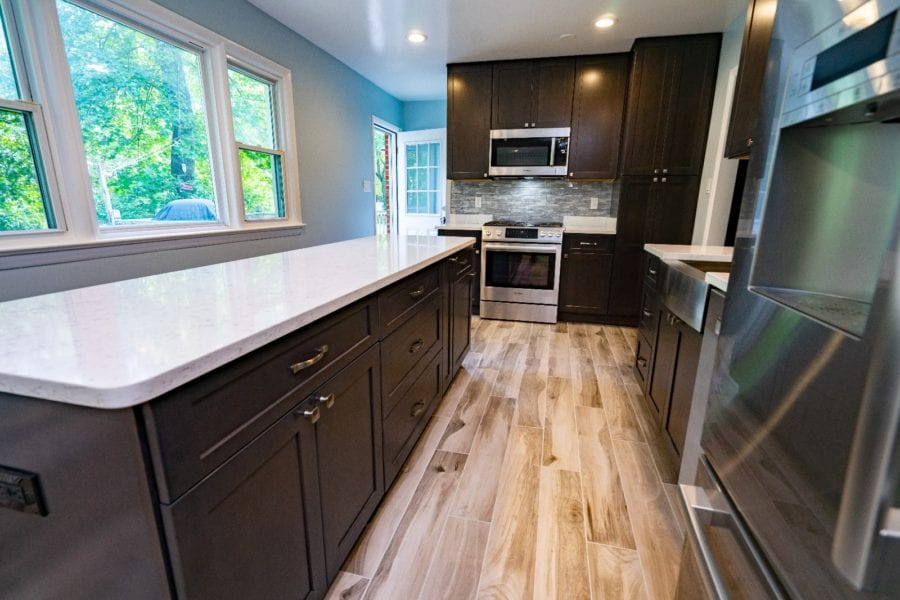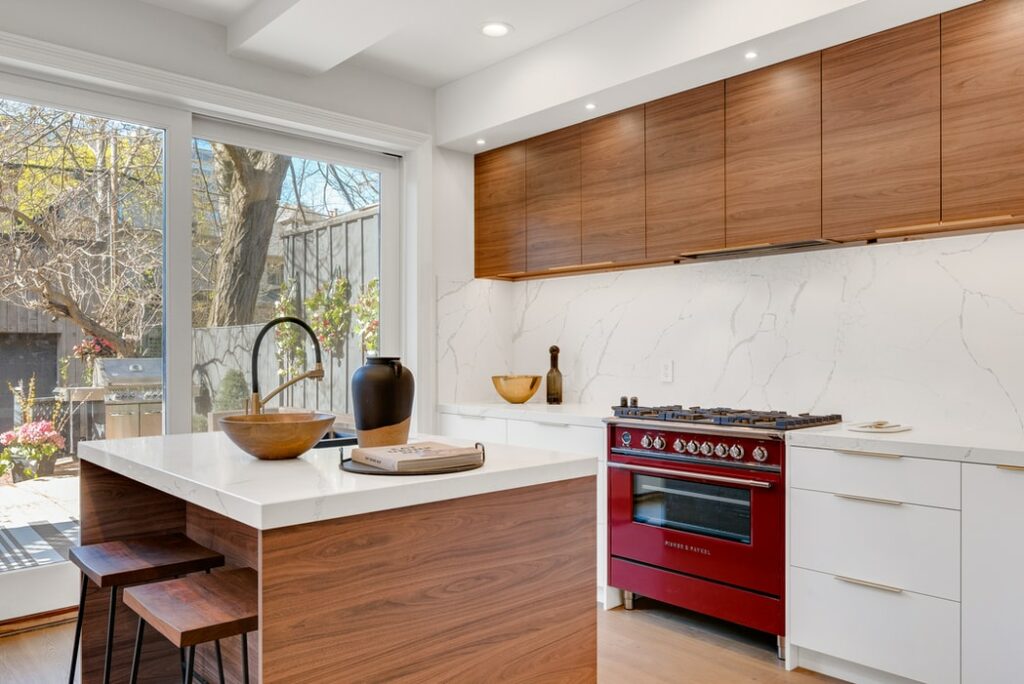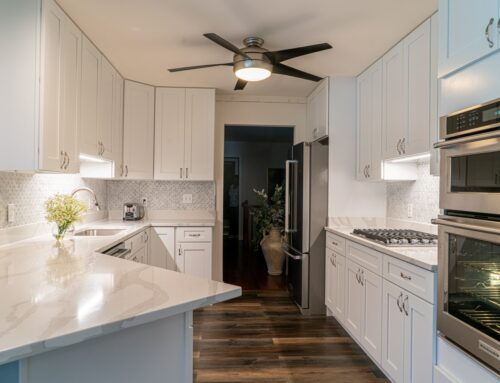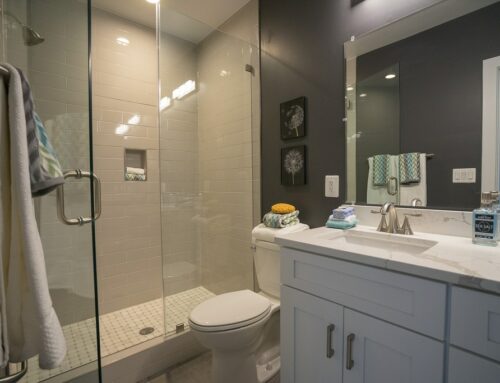While remodeling your kitchen, you can effectively personalize the space by installing custom kitchen cabinets. You can also add an element of consistency to your home?s decor this way. After choosing the style and kind of cabinets you need for remodeling your kitchen, you can finish the look using many effective ways. Today, there are a multitude of beautiful kitchen cabinet finishes for you to choose from.
Each of them is unique and can add a new dimension of attractiveness to your cabinets. That can help you finally turn the kitchen of your dreams into a thriving reality.?
When you are working with the custom cabinet designs, you need to ascertain which of the kitchen cabinet finishes will best suit your space. Modern kitchen designs tend to use one of five different finishes ? laminate, polyurethane, lacquer, veneer, and back-painted glass.
You can pick an option over the others depending on your home design, lifestyle, and budget. For that, you need to understand the characteristics, advantages, and disadvantages of each of these kitchen cabinet finishes. This guide aims to help you with this purpose and edge you closer towards your goal of perfecting your kitchen.
High-Pressure Laminates

You can easily consider laminates as the most popularly used kitchen cabinet finishes. Laminate comes in the form of a rigid decorative sheet of thickness ranging from 0.6 mm to 1.5 mm. You can craft them using a blend of plastic substances and paper.?
Under high temperature and pressure, this process results in the formation of decorative laminate sheets. Today, laminates are available in a variety of shades like metal, woodgrain, and stone.
Laminate is highly versatile and has something to offer for everyone, regardless of their preferences. Laminate kitchen cabinets are composed of layers of pressed paper, with a customized layer on top. You fuse these layers with high pressure and temperature. Later, you paste it onto a wood substrate using a suitable adhesive.
Melamine Laminate
Laminate is also available in another form ? melamine. Melamine resins are pressed with sheets of paper dipped in a phenolic resin used to create plastic. Moreover, they possess varying thickness, and the surface material is compressed under relatively lower pressure compared to other laminates.
Melamine cupboard doors use either particleboard (pieces of softwood) or MDF (timber fibers) with a square-edged profile. The melamine resin itself fuses the given substance onto the board, thus acting like an adhesive.
What Are the Pros and Cons of Laminate?
You can use melamine and laminate kitchen cabinet finishes using a low or high gloss, depending on the look you are aiming for. Both of them are durable, economically priced, and you can install them with relative ease. They are also convenient to clean and easy to maintain. If needed, you can choose to take them off and get them repainted in order to restore their looks.
However, you need to remember that their color can get chipped, and edging can start peeling off. Similarly, you can also damage the surface due to sharp tools or corrosive liquids. Fortunately, their advantages far outweigh the negatives. As long as you maintain them properly, laminates can enhance the look of your kitchen for several years.
Veneer

Photo by Andr? Fran?ois McKenzie on Unsplash
Veneers share a lot of similarities with laminates. However, they are prepared using thin slices of wood rather than paper. Their nomenclature is pretty straightforward, as well. Oak veneer refers to a sliced layer of oak wood, and so on.
Veneers are invariably crafted from wood, and thus they possess a woody appearance and wood grain patterns without exception. They resemble natural wood much more closely than woodgrain laminates. However, they are also more fragile in comparison, and you need to handle them gently.
Polyurethane (PU)
Polyurethane kitchen cabinet finishes have been steadily rising in popularity over recent years. That is largely by their versatility and the attractive shine that they possess.
Speaking of the material itself, polyurethane closely resembles molten plastic and you can generally apply it as a spray. You can expect it to take around twelve hours to get hardened. After you harden it, the PU assumes the form of a durable, protective shell over the wood.
Polyurethane doors have to be painted, buffed, and baked thrice in order to obtain a smooth look. You can get this finish in high gloss or satin versions. After that, you have to seal the edges using vinyl paint.
Polyurethane possesses a high degree of customizability, from the color to the strength of the material. It is convenient to clean and repair. You can fill cabinet doors and respray to rejuvenate their looks. It is an excellent choice for handle-less kitchen cabinets as well. Sealed edges featuring polyurethane can produce a beautiful profiled finish.
What Are the Pros and Cons of Polyurethane?
Polyurethane provides a charming shine to wooden items in your kitchen. You can also use it to enhance the look of wooden flooring. Not only is polyurethane finish sturdy and tough, but it is also resistant to scratches and other mechanical trauma. Thus, it has been receiving a lot of approval among contemporary homeowners. We expect this trend to keep rising in the near future.
However, polyurethane is also much more expensive than the budget-friendly laminate. Also, keep in mind that you need to select the polyurethane manufacturer carefully. That is because the quality of the material they offer can vary significantly.
If you end up with a lower quality door, you may find it chipped, discolored, or suffering from peeling later. And then, there is also the issue of expensive applications. However, thanks to its sleek looks, polyurethane can still be a great addition to your kitchen.
Lacquer
Lacquers are resin-based solutions that turn into a tough, transparent film upon drying. After being exposed to air, lacquer tends to get dried up much more rapidly than polyurethane. Thus, applying a lacquer finish takes much less time compared to a polyurethane finish.
Back-painted Glass
The name of back-painted glass gives away a lot of details. Back-painted glass is a form of strengthened glass. You can paint it in various shades on the back.?
A back-painted glass finish helps open up your kitchen and gives a more modern and bright design to your kitchen remodel.





